817 Search Results for praactical teaching
October 3, 2016
by Carole Zangari -
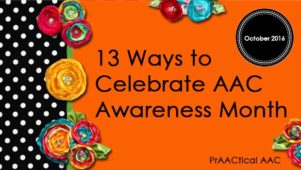
Need some ideas for celebrating AAC Awareness Month? Here are a few to get you started. Participate on the #USSAAC Twitterchat on 10/13 at 7:00 pm EDT (UTC−04:00). New to Twitterchats? You can learn more here. The wonderful Chris Bugaj will be moderating. Subscribe to a blog with an AAC content, such as Uncommon Sense, Jane Farrall Consulting, AAC Girls, or Superpower Speech Follow a new AAC topical Pinterest board from Lauren Enders and others: AAC and AT, AT/AAC/Adapt/Modify/Accessibility/Accommodations, AT for Communication, SLP AAC, & AugComm, AAC by Constantly Speaking, Communication-AAC Print, hang, or give someone an AAC awareness image, 10 Commandments of AAC Devices, or 5 Tips for Communicating with Nonverbal Student Register for a free AAC professional development webinar from Ablenet University Print out an AAC Poster, like Lauren Enders’ AAC Boot Camp-Getting AAC Users to Communicate or Kate Ahern’s The Periodic Table of AAC, Explore an AAC app or SGD that is new to you Print out song visual... [Read More...]
September 19, 2016
by Carole Zangari -

Our Site of the Month addresses a topic relevant to many of you who serve AAC learners. The Project Core website is the public face of a research project looking at the use of an AAC intervention program that uses a consistent set of core vocabulary that grows with the learner over time. The multi-tiered system for augmenting language used in this project begins with extensive aided language input and explicit instruction of selected core words during meaningful interactions throughout the school day. This forms a foundation on which more specialized and individualized intervention and vocabulary selection is built. The project is part of the Center for Literacy and Disability Studies at the University of North Carolina at Chapel Hill where the team has been developing a classroom-friendly intervention approach based on the System for Augmenting Language that was pioneered in the 1990s and continues to build an evidence base... [Read More...]
September 7, 2016
by Carole Zangari -
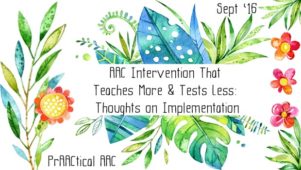
In an earlier post, I shared a graphic on the ways that AAC skills are ‘taught’ versus ‘caught.’ Teaching AAC skills involves the use of specific instructional strategies that give learners information and experiences which result in them being able to communicate more effectively. In many instances, we set out to do just that, but end up with an interaction that ‘catches’ what the student already knows how to do, rather than helping them gain additional skills. There are a few important concepts here. They both have an important role. ‘Catching’ skills isn’t bad. We can do this to figure out what the learner already knows/can do, and give him/her practice with the skill so that it becomes faster and easier to produce. When our interactions ‘catch’ a skill, we’ve created (or taken advantage of) an opportunity for communication. That’s important BUT, it isn’t teaching them anything new. Our learners do... [Read More...]
July 27, 2016
by Carole Zangari -
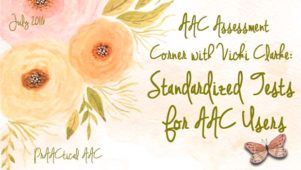
Do you have a love-hate relationships with formal testing? Are you required to use normed tests with your minimally verbal clients? Looking for recommendations on which tests to use? AAC specialist Vicki Clarke has you covered! Like many of you, I’ve had mixed feeling when it comes to using normed assessment instruments with my AAC learners, particularly when we needed to modify the test materials or administration procedures in order for them to be able to participate and respond. If the client can’t point to pictures, give a verbal response, or sit through an entire test, we have no choice but to adapt how the test is administered. As we all know, when we adapt test materials (e.g., putting the test items on an eye gaze board) or procedures (e.g., partner-assisted scanning), we lose the ability to use the normative data. We can, though, compare our learners to themselves at... [Read More...]
July 18, 2016
by Carole Zangari -
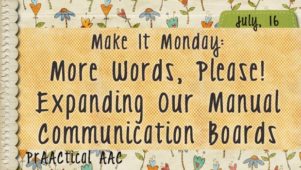
It’s another Make It Monday, our series on preparing core vocabulary materials for use with AAC learners. When we left off last week, we selected or created manual communication boards (MCBs) with a starter set of core words. Today, we pick up that thread by adding more words. If you are working with teams that are new to AAC implementation, have a difficult time with change, or are showing resistance to this “whole AAC thing,” you might want to start off slowly and use just the main communication board for a few weeks to build everyone’s confidence. You can add more words once they are implementing it fairly well. The way I see it: Strong implementation of a basic core board is better than weak implementation of a more robust board. It doesn’t take very long, though, to realize that as versatile as our core word MCB is, there simply... [Read More...]
July 5, 2016
by Carole Zangari -

Summer is a great time to prepare materials for the busy year ahead. Next week, we launch a new series, Make It Monday, to help you do just that. We’ll focus on creating one thing at a time so that you’re ready to start the school year with an ample supply of core vocabulary resources that you can use in therapy, instruction, and informal conversation. Later in the series, we’ll be making individual and classroom communication boards and instructional materials. For now, though, we’ll spend some time getting organized and prepared. Before you make the investment of time and resources, it helps to make a few key clinical/educational decisions. This will keep us from wasting color ink, laminating pouches, velcro, and, most of all, time. Here are the things to think about before you begin. Symbols In order to make AAC materials, you’ll need to decide on how language is... [Read More...]
May 4, 2016
by Carole Zangari -

How can we boost the frequency of core vocabulary use across environments? Planning those opportunities and teaching experiences is a big part of that process, both for those new to this approach and those who’ve been doing it for awhile. In this week’s featured video, Gail Van Tatenhove offers ideas for how to structure this so that it is feasible and successful. Thanks to Prentke Romich Deutschland for making ‘Core Counts’ available. Direct link to video: https://www.youtube.com/watch?v=E-xfv3VpvAg
April 29, 2016
by Carole Zangari -
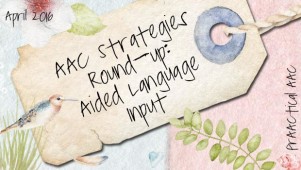
We’ve been writing about aided language input, a pivotal strategy for supporting AAC learners, for several years. In fact, there are over 200 posts tagged with this term. In this post, we gather together some of the most popular posts on this fundamental intervention strategy. Implementation A PrAACtical Idea for Aided Language Input Using Aided Language Input to Build Communication Opportunities! How I Do It: Implementing Aided Language Input with Alicia Garcia Pivotal Skills for AAC Intervention: Aided Language Input How We Do It: Controlled Practice in Partner Augmented Input with Jill Senner & Matthew Baud Text-Based Aided Language: Making the Literacy-Communication Connection for Children with Autism Videos PrAACtical Resources: Video Explainers for Aided Language Input Video of the Week: Aided Language Input with Gail Van Tatenhove Video of the Week: Aided Language Input with Dr. Caroline Musselwhite PrAACtical Resources: Video Examples of Aided Language Input Aided Language Input in... [Read More...]
March 2, 2016
by Carole Zangari -

In this week’s video, we feature SLP Shannon Hennig who talks to us about some of her strategies for teaching language learners. As with her previous video, Shannon’s suggestions are clear, relevant, and prAACtical. Enjoy!
February 25, 2016
by Carole Zangari -
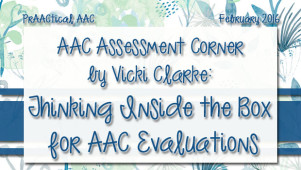
AAC assessment is a challenge in almost every service delivery setting, and many of you have reached out to us to ask for advice on how to strengthen your assessment practices. Luckily, Vicki Clarke, an AAC Chick who has a great deal of experience assessing learners in clinical and educational settings, has tips and resources to share. In this continuation of the AAC Assessment Corner series, Vicki talks about a key feature in any AAC system: vocabulary organization. ::::::::::::::::::::::::::::::::::::::::::::::::::::::::::::::::::::::::::::::::::::::::::::: Thinking Inside the Box for AAC Evaluations: What Type of Vocabulary Organization is Right For Your AAC User? Professionals often spend a great deal of time concerning themselves with which box they should get their AAC user. Should I pick a Prentke Romich or a Tobii Dynavox? But what about the iPad? And what about the money? Should I pick a CheapTalk or a GoTalk instead? Here’s the good news: The box is not the... [Read More...]









